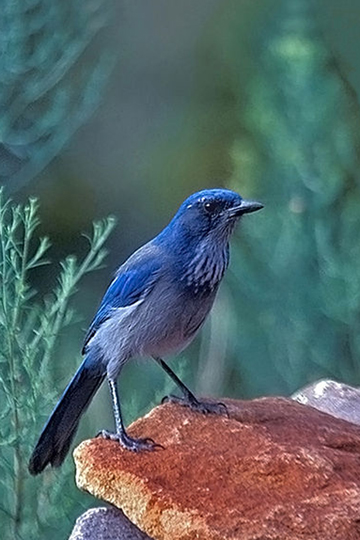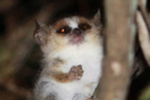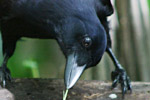The western scrub jay (Aphelocoma californica) is a common denizen of suburban neighborhoods in the U.S., loitering at bird feeders and amusing bird watchers with their entertaining antics. Known to birders as ‘WESJ,’ this handsome bird is non-migratory and territorial during the breeding season, but what’s curious about WESJ’s is the way they respond to risks in their environment. When descended on by a predator or encountering a dead member of its kind, these birds hop from perch to perch and call loudly, ensuing in a ‘cacophonous reaction,’ a term coined by researchers at the University of California, Davis who are studying the behavior of these unique birds.
In a series of experiments, scientists presented a host of potential hazards to jays in order to observe their responses. Animals react to perceived threats in their environment by changing their behavior, such as changing foraging habits, altering periods of activity, fleeing a site, attacking intruders, and avoiding certain areas. Jays in this experiment responded similarly: by becoming wary and warning other jays through vocalizing, gathering together, and reducing foraging.
 Western scrub-jay in New Mexico. Photo by: Peter Wallack. |
The scientists first tested how they birds responded to others of their kind. Mounted, dead jays (portrayed in life-like postures) were perceived as intruders, with live jays acting aggressively toward them; however, dead, belly-up jays were perceived as a sign of potential danger and were never acted aggressively toward. Instead, live jays responded by calling loudly and gathering together to form a aggregation- “cacophonously aggregating.” The first individual to encounter the dead bird would call, beginning a chain reaction. Birds in the surrounding area were attracted by the calls and, in most instances, came closer to the bird generating the alarm call.
It was clear that when presented with a threat, western scrub jays respond by altering their behavior. Why is it though, that they responded with a cacophonous aggregation to the dead jay–which some have likened to a funeral? Explanations for this behavior vary. One theory is that by vocalizing and congregating, jays create a ‘mob’ to warn other jays in the area of the danger. For example, the sight of a predator would cause jays to vocalize, reduce foraging, and warn other jays, but, notably, a dead jay elicited a similar response, as did vocalizations of jays giving alarm calls. This leads researchers to believe that jays use those vocalizations as “a public service announcement” about risks even though they did not witness the animal being killed. Such behavior is unusual for a territorial species.
Territorial animals expend large amounts of energy maintaining a territory and ensuring that intruders do not infringe on them, so warning competitors of potential hazards seems counterintuitive. As lead author Iglesias tells mongabay.com, “…a dead bird means danger for them too in that area [potential predation].” So why waste time and energy helping other birds instead of merely avoiding the hazards themselves? Perhaps jays are exhibiting some form of altruism here.
Altruism means showing concern for the welfare of others; in a biological context, this means altering your behavior, and possibly even putting yourself in danger, to reduce the risks to another member of your species. For instance, jays, being territorial, typically display aggression toward other jays when they meet–they are, after all, competitors. But the researchers at UC Davis noticed that in their experiments, jays reduced and even ceased aggressive behavior toward each other when threatened. Some scientists believe that there is a selfish motive behind this façade of kindness: animals displaying altruism may be helping others to ensure the survival of their species.
The season may have something to do with the jay’s responses as well. The experiments were conducted over several months, capturing the height of the breeding season as well as pre- and post- breeding. It is believed that responses of adult jays may be different when fledglings are present or when environmental conditions differ. Iglesias and the researchers at UC Davis have conducted additional experiments with the jays, manipulating additional variables, and plan to publish their results in the upcoming months.
Iglesias hints, “it gets interesting…that’s all I can say about that.”
CITATION: Iglesias, T. L., R. McElreath, and G. L. Patricelli. 2012. Western scrub-jay funerals: cacophonous aggregations in response to dead conspecifics. Animal Behaviour (2012), http://dx.doi.org/10.1016/j.anbehav.2012.08.007.
Related articles
Despite small brains, gray mouse lemurs use calls to avoid inbreeding

(12/03/2012) As a small-brained and largely solitary primate, the gray mouse lemur (Microcebus murinus) wasn’t supposed to have the capacity to distinguish the calls of its kin calls from other lemurs. However, a new study in BMC Ecology, finds that a female gray mouse lemur is able to determine the mating calls of its father, allowing it avoid inbreeding. The discovery challenges the long-held belief that only large-brained, highly social animal are capable of determining kin from calls.
New Guinea singing dog photographed in the wild for the first time
(12/03/2012) A rarely seen canine has been photographed in the wild, likely for the first time. Tom Hewitt, director of Adventure Alternative Borneo, photographed the New Guinea singing dog during a 12-day expedition up a remote mountain in Indonesian Papua. Very closely related to the Australian dingo, the New Guinea singing dog, so named for its unique vocalizations, has become hugely threatened by hybridization with domesticated dogs.
Endangered muriqui monkeys in Brazil full of surprises

(11/26/2012) On paper, the northern muriquis (Brachyteles hypoxanthus) look like a conservation comeback story. Three decades ago, only 60 of the gentle, tree-dwelling primates lived in a fragment of the Atlantic Forest along the eastern coast of Brazil. Now there are more than 300. But numbers don’t tell the whole story, according to anthropologist Karen Strier and theoretical ecologist Anthony Ives of the University of Wisconsin, Madison. The pair analyzed 28 years of data on the demographics of the muriquis, one of the longest studies of its kind. They found surprising patterns about birth and death rates, sex ratios, and even how often the monkeys venture out of their trees. These findings raise questions about the muriquis’ long-term survival and how best to protect them, the scientists wrote in the Sept 17 issue of PLoS ONE.
Great apes suffer mid-life crisis too

(11/19/2012) Homo sapiens are not alone in experiencing a dip in happiness during middle age (often referred to as a mid-life crisis) since great apes suffer the same according to new research in the Proceedings of the National Academy of Sciences (PNAS). A new study of over 500 great apes (336 chimpanzees and 172 orangutans) found that well-being patterns in primates are similar to those experience by humans. This doesn’t mean that middle age apes seek out the sportiest trees or hit-on younger apes inappropriately, but rather that their well-being starts high in youth, dips in middle age, and rises again in old age.
Clever crows may grasp hidden causes

(11/15/2012) Crows may be imagining more than we imagined. New research suggests certain crows make decisions based on factors they can’t see. A recent study published in the Proceedings of the National Academy of Sciences (PNAS) deepens our understanding of these crafty corvids, and could help explain how human reasoning evolved. Crows are intelligent problem solvers, capable of making hook-shaped tools to retrieve food and using multiple tools in a logical sequence. New Caledonian crows (Corvus moneduloides) are particularly adept tool users, and have often been the subject of cognitive research. In this study, the New Zealand–based researchers tested whether New Caledonian crows could trace an event back to a cause that was hidden from their view.